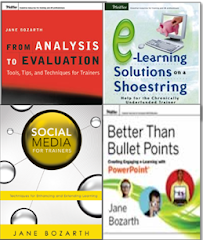This month's "Nuts & Bolts" column examines social learning as it happens naturally, organically, as people go about their day:
It’s not about ‘doing social.’ It’s about supporting workers as they work by giving them the time and the right space to talk about it. It’s about listening. And it’s about using social tools to support conversations and performance already in progress.upporting workers as they work by giving them the time and the right space to talk about it. It’s about listening. And it’s about uScenario A: An international company rolls out a new product. The trainers are thrilled with it and, despite some technical glitches, eagerly hop on to learn more about it. There isn’t much user support, so understanding more about specifics of the product proves to be a collaborative proposition. Trainers working with the product run into each other and talk, sometimes teaming up to work together.
It’s not about ‘doing social.’ It’s about supporting workers as they work by giving them the time and the right space to talk about it. It’s about listening. And it’s about using social tools to support conversations and performance already in progress.upporting workers as they work by giving them the time and the right space to talk about it. It’s about listening. And it’s about uScenario A: An international company rolls out a new product. The trainers are thrilled with it and, despite some technical glitches, eagerly hop on to learn more about it. There isn’t much user support, so understanding more about specifics of the product proves to be a collaborative proposition. Trainers working with the product run into each other and talk, sometimes teaming up to work together.
The company hasn’t provided any collaboration tools, so the trainers across locations begin talking in places like Facebook groups, Google communities, and Reddit. They share tips via text posts as well as screenshots, audio commentary, and video clips. A few create video tutorials about product features or shortcuts.
Something like a community of practice—in which people work together to get better with the product—develops, showing hallmarks like a common vocabulary, accountability to the effort and each other, and in-jokes. There’s fun and energy around conversations. Master trainers emerge: Some commenters try to game the system but are mostly shut down by the other trainers. Some post wrong information, but it’s caught and corrected. The company keeps an eye on the activity and announces it will make adjustments to the product based on feedback gleaned from the community.
Scenario B: An international company rolls out a new product. The trainers are thrilled with it and, despite some technical glitches, eagerly hop on to learn more about it. The company sets up an internal social platform that allows for text posts and photo attachments.
Trainers are assigned to “communities”—separate discussion areas—based on their geographic location. The initial post on all forums is a disclaimer from HR advising trainers of guidelines for participating in discussions and reminding them of company communication policies. Each forum has a designated manager who facilitates conversation by supporting, redirecting, and if necessary deleting comments.
Few people participate, and when they do they’re usually just posting a hint or two, complaining about a problem, or asking for help. Responses are sporadic, and back-and-forth conversation is minimal. People report glitches and offer ideas for improving the product, but the developers are not members of the communities, so the feedback never reaches them.
Scenario B describes most failed initiatives at companies attempting to “do” social.
Scenario A is … Pokémon Go.*
You can access the rest of this article at Learning Solutions Magazine .










